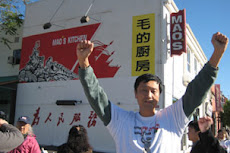 陈凯博客: www.kaichenblog.blogspot.com
陈凯博客: www.kaichenblog.blogspot.com Leftists Embrace North Korea — And China
美/西左分子为朝、中专制呐喊
by William R. Hawkins
on Dec 3rd, 2010 and filed under FrontPage.
http://frontpagemag.com/2010/12/03/leftists-embrace-north-korea-and-china/
The ANSWER (Act Now to Stop War and End Racism) Coalition called for “emergency protests” in Washington, DC and California last weekend to prevent a “new Korean War.” ANSWER had been one of the leading groups staging mass demonstrations against early U.S. military operations in Iran and Afghanistan, but their efforts petered out. The group’s opposition to American foreign policy has not slackened. Its statement issued Nov. 26 placed full blame for the Korean crisis on “the Obama administration and its South Korean client government led by the rabidly anti-communist President Lee Myung-bak.”
ANSWER claims:
The crisis there is the result of a policy of deliberate provocation by the U.S. and South Korea over the past several months. These provocations are targeting both the DPRK and the People’s Republic of China, countries where the often-concealed but very real aim of U.S. leaders — Democrats and Republicans alike – is regime change.” This line is taken directly from Beijing’s hard-line rhetoric during the summer when the United States discussed holding joint exercises with South Korea in the Yellow Sea, but did not do so. Still, ANSWER blames the allies for a “threatening message of escalation since China considers these waters to be part of its sovereign territory.
China’s claims are, however, illegal under the international law of the sea. The Yellow Sea is not Beijing’s territory or even “territorial waters.” China is attempting to convert its rights in a 200 mile “exclusive economic zone” into sovereign control, which is not a proper interpretation of the law. “We hold a consistent and clear-cut stance on the issue. We oppose any party to take any military actions in our exclusive economic zone without permission,” said a statement by the Foreign Ministry on Nov. 25. Yet, free navigation is allowed through any EEZ as the traditional use of international waters. It should also be noted that China is not the only country opening onto the Yellow Sea, South Korea does as well.
Throughout the summer, there were bellicose editorials in the state-run Chinese media about how any show of force against Pyongyang was a threat to China, and that Beijing needed weapons to “kill” American carriers. This union of interest between the two communist regimes recalled the earlier Korean War (1950-53) when Chinese troops intervened to prevent the collapse of North Korea after its failed invasion of South Korea.
But China’s claims run far beyond the Yellow Sea. There were a series of diplomatic disputes during the summer, as Beijing attempted to incorporate the South and East China seas into its domain. China held military exercises in all the adjacent waters, provoking a backlash that manifested itself at the Association of South East Asian Nations (ASEAN) summit in June at which the U.S. backed the smaller states against Chinese claims. The aircraft carrier George Washington and its escorts sailed through the South China Sea to support U.S. diplomacy just as it is doing today in the Yellow Sea.
There was no mention in the ANSWER discussion of the sinking of the South Korean corvette Cheonan by a North Korea submarine last March with the loss of 46 lives. There was no retaliation against Pyongyang for this act of war, only the holding of military exercises meant to show the solidarity of the U.S.-ROK alliance. The deterrent effect of these maneuvers was weakened by President Barack Obama’s decision not to send a carrier group into the Yellow Sea where the Cheonan went down. Instead, operations were moved to the Sea of Japan away from China, a change that Beijing undoubtedly considered a victory.
The South Koreans did hold exercises in the Yellow Sea and ANSWER claimed this justified North Korea’s attack on Yeonpyeong island. That there is a major difference between practice firing weapons in the open sea and firing artillery at populated areas across a boundary was lost on ANSWER.

































No comments:
Post a Comment